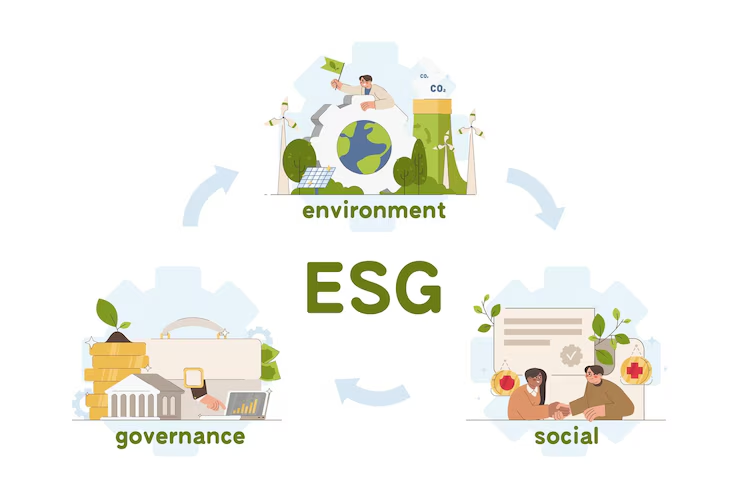Today's businesses are no longer solely driven by profit; they're also racing to fulfill their responsibilities. The concept of sustainable development is no longer an option but a guiding principle for any enterprise aiming for long-term growth and success. Within this imperative, ESG (Environmental, Social, and Governance) principles are pushing organizations to continuously enhance their commitment to the community.
However, how can these "green" and "humanitarian" commitments move beyond mere declarations and truly permeate every aspect of operations, becoming measurable metrics? This is precisely where integrating ESG into ERP (Enterprise Resource Planning) systems becomes a strategic solution, opening the door to unprecedented transparency, efficiency, and adaptability. Learn more in the following article.
1. The Context and importance of ESG in the ew Era

For businesses today, pure profit is no longer the sole measure of success; instead, the ability to generate sustainable value for society and the environment is gaining increasing importance. This is the backdrop against which ESG has emerged – a comprehensive framework that helps investors, partners, and even consumers evaluate a company's performance based on three core pillars: Environmental, Social, and and Governance. Specifically:
- E - Environmental: This pillar examines a company's impact on the natural environment. This includes managing carbon emissions, resource and energy consumption (water, raw materials), waste management, and climate change initiatives. A company with low emissions, effective recycling programs, and the use of renewable energy sources will score highly in this aspect.
- S - Social: The social aspect focuses on how a company interacts with its stakeholders, from employees, customers, and suppliers to the broader community. Key factors include fair labor practices, diversity and inclusion, product safety, data privacy, and positive community contributions.
- G - Governance: The governance pillar relates to how a company is run. This includes the leadership structure, transparency in financial reporting, business ethics, anti-corruption policies, shareholder rights, and the independence of the board of directors. A robust governance system ensures the company operates responsibly and efficiently.
2. Why ESG is crucial for Vietnamese Businesses

For Vietnamese businesses, embracing and practicing ESG is no longer an option but an urgent requirement, offering numerous strategic benefits:
Attracting International Investment and Partnerships: Global investors increasingly prioritize companies with clear ESG strategies. Similarly, many multinational corporations demand strict ESG compliance from their supply chain partners. Failing to meet these standards can cause businesses to lose out on significant opportunities.
Enhancing Reputation and Brand Image: In a competitive market, demonstrating environmental and social responsibility helps businesses build trust with customers, partners, and the public. This creates a sustainable competitive advantage, attracting loyal customers and improving reputation.
Mitigating Risks and Optimizing Costs: Proactive management of ESG factors helps businesses identify and mitigate legal, reputational, and operational risks (e.g., resource scarcity risks, energy price volatility). Concurrently, ESG initiatives such as energy saving and efficient waste management also help optimize operational costs.
Driving Sustainable Development: ESG is not merely about compliance but also serves as a guiding principle for businesses to innovate, adapt to new regulations, and create long-term value for all stakeholders. This is the path for Vietnamese businesses not just to survive, but to thrive in the future.
3. Challenges in traditional ESG data management

Despite the growing awareness of ESG's importance, traditional ESG data management presents significant challenges, making it difficult for businesses to gain a comprehensive and accurate view.
Fragmented and dispersed data
Firstly, ESG data is often fragmented and dispersed, rarely residing within a single, unified system. Instead, it's scattered across various departments: emissions data might be in production, gender diversity information in HR, and community investment details with communications or accounting. This creates a complex matrix that requires substantial effort to aggregate and reconcile, leading to the risk of missing or duplicating information.
Lack of standardization and transparency
Secondly, there's a lack of standardization and transparency. Unlike financial data, which adheres to established accounting principles, ESG data often lacks consistent definitions and measurement methodologies within the organization. Each department may collect data in its own way, leading to inconsistencies and difficulties in comparison. This not only complicates internal analysis but also reduces reliability when reporting externally, making businesses vulnerable to accusations of "greenwashing" without transparent evidence.
Manual and time - consuming reporting processes
Thirdly, manual and time-consuming reporting processes are a major hurdle. With dispersed and unstandardized data, preparing ESG reports often becomes a significant manual burden. Companies spend hours, even weeks, collecting, inputting, verifying, and formatting information from various sources. This process is not only resource-intensive but also carries a high risk of errors, especially as reporting requirements become increasingly detailed and frequent.
Difficulty in analysis and strategic decision-aking
Finally, difficulty in analysis and strategic decision-making is a critical challenge. When data is not centralized and standardized, transforming it into valuable insights becomes arduous. Businesses struggle to analyze trends, benchmark performance against industry standards, or identify areas for improvement. This hinders data-driven decision-making, reduces the effectiveness of ESG initiatives, and slows down a company's ability to adapt to increasing market and regulatory pressures.
4. Integrating ESG into ERP systems: A breakthrough solution for businesses

Facing the challenges of traditional ESG (Environmental, Social, and Governance) data management, integrating ESG into Enterprise Resource Planning (ERP) systems is emerging as a highly effective trend. ERP systems have long been considered the "heart" of any business, centralizing and managing nearly all core operational processes—from finance, manufacturing, and supply chain to human resources. Leveraging this robust platform to integrate ESG activities and data is a strategic move, transforming ERP into a powerful tool that supports sustainable business development.
Why Integrate ESG into ERP?
Centralized Data: ERP becomes the single source of truth for a company's ESG data. Instead of scattered information across various departments, all relevant environmental (energy consumption, emissions), social (labor safety, workforce diversity), and governance (financial transparency) data is collected and stored in one place, ensuring consistency and easy access.
Automated Processes and Enhanced Accuracy: An ERP system enables the automation of ESG data collection, calculation, and reporting from daily operations. This significantly reduces manual effort and minimizes errors, ensuring the accuracy and reliability of ESG data, and mitigating the risk of "greenwashing" accusations.
In-depth Analysis and Decision Support: With ESG data structured and centralized within ERP, businesses can leverage the system's powerful analytical tools. This makes it easier to identify trends, assess ESG performance over time, benchmark against industry standards, and pinpoint areas for improvement. This detailed insight forms a solid foundation for leadership to make strategic decisions and promptly adjust sustainability initiatives.
Simplified Compliance: International ESG reporting standards (such as GRI, SASB, TCFD) are becoming increasingly complex. Integrating ESG into ERP helps businesses automate the generation of compliance reports, ensuring full and accurate adherence to requirements, and reducing pressure and legal risks.
ERP modules that can integrate ESG
Most core ERP modules have significant potential for integrating ESG data and processes:
- Production Management: Detailed tracking of energy, water, and raw material consumption; measurement of carbon emissions from production activities; and management and optimization of waste generation.
- Supply Chain Management: Assessing and selecting suppliers based on ESG criteria (e.g., labor conditions, environmentally friendly production processes); tracking and calculating emissions throughout the supply chain; and optimizing logistics to reduce emissions.
- Finance/Accounting: Recording and tracking ESG-related costs (e.g., waste treatment expenses, investments in green technology); analyzing the financial performance of sustainability projects; and integrated financial reporting with ESG information.
- Human Resources Management (HRM): Tracking Diversity, Equity, and Inclusion (DEI) metrics; managing and reporting on occupational health and safety; monitoring employee well-being and satisfaction; and ensuring compliance with labor regulations.
- Quality Management: Ensuring environmentally friendly products throughout their lifecycle; managing product sustainability certifications; and minimizing waste in quality control processes.
- Reporting & Analytics: This module aggregates data from other modules to automatically generate required ESG reports, providing intuitive dashboards for real-time ESG performance monitoring and supporting strategic decision-making.
For instance, Odoo integrates ESG (Environmental, Social, and Governance), embedding sustainability at the core of its ERP system.
Odoo is set to launch a brand-new application that will enable businesses to calculate their ESG metrics and carbon footprint directly within the ERP platform. This marks a significant step forward in sustainable management. The application leverages purchasing data and emission factors to track detailed carbon emissions, while also allowing for the automatic generation of reports compliant with the EU's CSRD (Corporate Sustainability Reporting Directive), all directly from the system. This full integration not only eliminates the reliance on costly and complex external platforms but also makes it easier for businesses – especially SMEs – to access and achieve their sustainability goals more efficiently and cost-effectively than ever before.
5. Superior benefits: Integrating ESG into ERP tems

Integrating Environmental, Social, and Governance (ESG) principles into an Enterprise Resource Planning (ERP) system is more than just a technological upgrade; it's a strategic investment that delivers exceptional benefits, reshaping how businesses operate and develop for the long term.
Enhanced competitiveness and stakeholder attraction
In an environment where investors are increasingly prioritizing sustainability, an ERP system that offers transparent ESG data enables businesses to attract green investment funds, access preferential capital, and engage with international partners who demand high standards of social and environmental responsibility. Simultaneously, the image of a responsible enterprise helps to attract and retain customers who are increasingly conscious of sustainable consumption.
Optimized operational efficiency and cost reduction
By closely monitoring key metrics like energy consumption, water usage, and waste management through the ERP system, businesses can easily identify areas of inefficiency. This allows them to implement process improvements in production and operations, leading to significant cost reductions and overall efficiency gains. For instance, real-time tracking of emissions and energy consumption can drive substantial energy-saving initiatives.
More effective risk management
ESG data integrated within the ERP provides businesses with a comprehensive view of potential risks related to environmental compliance (e.g., emission regulation violations), social aspects (e.g., labor disputes, product safety), and governance (e.g., lack of transparency). This proactive approach allows companies to develop preventive plans and mitigate negative impacts on business operations and reputation.
Improved brand image and reputation
An ESG-integrated ERP system enables businesses to substantiate their sustainability commitments with concrete data. This builds trust with the public, enhances brand value, and cultivates a positive, differentiated image in the market.
Attracting and retaining talent
Today's workforce, especially Gen Z and Millennials, are increasingly interested in the purpose and values of the companies they work for. A company that demonstrates a strong commitment to ESG through transparent activities and reporting becomes more appealing, not only in attracting talent but also in fostering an environment that encourages long-term employee retention.
6. Steps for integrating ESG into ERP Systems

Integrating Environmental, Social, and Governance (ESG) factors into an Enterprise Resource Planning (ERP) system is a strategic journey that requires meticulous preparation and systematic execution. To ensure a smooth process and maximum effectiveness, businesses should follow these steps:
Step 1: Assess current state and define ESG objectives
This is the most crucial initial step. Businesses need to conduct a comprehensive assessment of their existing ESG activities and data. It's essential to clearly identify which ESG aspects are material to their industry and business model (e.g., for manufacturing, this might be emissions and resource consumption; for service industries, it could be customer data management and employee welfare).
Step 2: Select a suitable ERP solution
Not all ERP systems offer the same level of ESG support. Businesses must evaluate the scalability, integration capabilities, and customizability of their current ERP system. If the existing ERP is insufficient, consider opting for a new solution or adding specialized modules that offer robust features for collecting, managing, and reporting ESG data. Prioritize ERP vendors with experience in sustainability and a clear development roadmap.
Step 3: Collect and standardize ESG data
Once the ERP foundation is in place, the next step is to establish processes for automatically and continuously collecting ESG data from various sources within the enterprise (e.g., production machinery, HR systems, accounting documents). Crucially, businesses need to set up standards and rules to standardize this data, ensuring its accuracy, consistency, and reliability. This includes clearly defining metrics, units of measurement, and collection frequency.
Step 4: Customize and configure the ERP system
Based on the identified ESG objectives and data types, the ERP system needs to be customized and configured for effective management. This involves setting up new data fields, building specialized ESG reports, and creating intuitive dashboards to monitor performance. In some cases, it will be necessary to integrate the ERP with other specialized systems, such as Environmental, Health, and Safety (EHS) management systems, to gain a more comprehensive view.
Step 5: Training and change management
Technology is only part of the solution. For successful ESG integration into ERP, businesses need to provide comprehensive training for employees at all levels on the importance of ESG, the company's objectives, and how to use the new ERP system to contribute to these goals. This also involves change management to ensure acceptance and cooperation from all departments, breaking down traditional silos between different functions.
Step 6: Continuous monitoring, evaluation, and mprovement
ESG integration is not a one-time project but an ongoing process. Businesses need to regularly monitor and evaluate ESG performance against established KPIs through the ERP system. Data and analytics from the ERP will help businesses identify strengths, weaknesses, and opportunities for improvement. From there, they can adjust their ESG strategy and system configuration to optimize effectiveness, ensuring the business continuously adapts and develops sustainably in a changing landscape.
8. Conclusion
Integrating ESG (Environmental, Social, and Governance) into ERP systems is no longer optional but an imperative for modern businesses. This integration optimizes operations, enhances efficiency, builds brand reputation, attracts investment, and creates a sustainable competitive advantage.
This is an investment in the future, helping businesses not only meet the escalating demands for sustainable development but also thrive. Embark on this transformation journey to elevate your business to new heights. Contact us for free resources and consultations on the latest technological solutions.